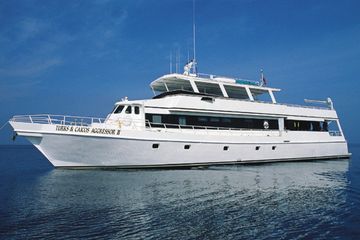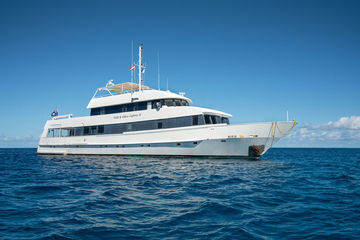Diving in the Turks and Caicos
Turks and Caicos are growing in popularity due to their calm water and famous Caribbean visibility. Huge elephant ear sponges and sea fans cover the sites but most come for the nurse, reef, hammerhead and tiger sharks. Grace Bay and Columbus Passage, where humpback whales visit, are considered some of the best.
Turks and Caicos scuba diving is a comparatively unknown destination in the Caribbean chain, yet has some of the best diving in this region, with calm, inviting crystal waters filled with a flourishing network of reefs, and notorious globally for the incredible, sheer coral walls that disappear into the depths of the sea to over two thousand meters (7,000 feet) at some dive sites. Living up to the country's motto of "beautiful by nature," the Turks & Caicos is an archipelago of over 40 islands, southeast of the Bahamas, adorned with white sand beaches, secluded bays, exquisite turquoise water and the third largest coral ecosystem on the planet.
Among the best dive sites in Turks & Caicos are those along the north coast of the main island of Providenciales, including the many in Grace Bay, that lie within the Princess Alexandra National Park where commercial and sport fishing has been banned for years. The results are predominantly undisturbed reefs filled with plentiful marine life. Dive trips, especially those aboard weeklong luxury liveaboards, offer the chance to truly explore these remarkable islands on as many as five dives per day, roaming from North West Point on Providenciales, also known as Provo, to West Caicos and French Cay.
2 Liveaboards in Turks and CaicosExplore all liveaboards
Diving in the Turks and Caicos FAQ
What marine life can I expect to see in the Turks and Caicos?
Scuba diving in Turks and Caicos offers the best of the marine life that the can be found in the Caribbean. The tranquil and lavish reefs, with their precipitous drop-offs, are home to enormous elephant ear sponges, colossal sea fans and a vibrant selection coral species. But for many divers, it's the big stuff that they come to see in the form of the many resident nurse and reef sharks, as well the occasional sightings of both tiger sharks and hammerheads.
Welcoming Nassau grouper, sea turtles, graceful manta rays and a special visit to dive boats by a pod of bottlenose dolphins are all certain crowd pleasers, but nothing is as impressive as an underwater encounter with one of the many female humpback whales passing through the area, during January to March, from the North Atlantic to the Dominican Republic to breed and give birth.
What are the best dive sites in the Turks and Caicos?
The sublime weather and ocean conditions mean that there are many amazing sites for diving in the Turks and Caicos, and each dive trip to the islands might have a unique itinerary as the dive spots you visit will depend on the wind and weather that week, along with your boat captain using his local knowledge and experience to choose the best of the best under those conditions.
Dive sites around Providenciales offer precipitous walls plunging from 15m (45 feet) down into the inky depths thousands of feet below.
North West Point dive sites, such as Shark Hotel, The Hole in the Wall, and The Black Forest, just off Provo, boast an assortment of soft and hard corals, tube sponges, resident schools of horse-eye jacks, crustaceans, and much more, but for many divers it’s the diversity of black corals (bushy, feathery, curly and trees) that are the main attraction, creating uniquely beautiful structures along the walls and a fair share of swim throughs.
Traveling east along the north coast of Providenciales, the dive spots in the stunning Grace Bay are protected from the outlying sea by a 14-mile-long barrier reef, where the top of the reef sits around 9 meters (30 feet) with deep canyons that descend into the depths. Dives sites including Graceland and Coral Gables bring divers up close and personal with reef sharks, turtles, barracuda and more, not to mention some personal attention from one of the friendly Nassau grouper living in the area.
Located 10 miles southwest of Provo, the uninhabited island of West Caicos is adorned with copious pelagics visitors swimming along pristine coral walls. Garden eels and stingrays hiding among the sandy flats are the prelude to the cliffs covered with staghorn corals and truly gigantic orange elephant ear sponges, while above the waves divers can catch a glimpse of wild flamingos and osprey.
The tiny, bird sanctuary atoll of French Cay, 15 miles south of Providenciales, may not look much above the waterline, but hidden below are shallow coral playgrounds and quintessential walls. Dive sites such as Double D, Half Mile and Rock &Roll abound with pillar corals, forests of sea fans, nurse sharks, lobsters and a multitude of colourful tropical fish.
What's the best time to dive in the Turks and Caicos?
There is no bad time of year to go scuba diving in the Turks and Caicos as the weather is nearly perfect year round. With that said, January to April is the islands' busiest season as many international travelers head away from the snow and chill at home, and winter also means the chance of humpback whale sightings.
The islands are blessed with very little rain in any season, enjoying a sunny, tropical climate and temperatures ranging from 29-32°C (85-90°F) in the summer months and 26-29C (80-85F) in the winter. Even in the coolest months, the nighttime temperatures rarely fall below 18C (64F).
Meanwhile, with only gentle sea breezes tickling the warm waters around the islands, conditions below the surface are typically calm, with visibility that can reach 30 meters (100 feet) and beyond. And as these Caribbean waters only cool to 29 - 25°C (84-78°F) in winter, most people diving in the Turks and Caicos will be happy with just a 3mm wetsuit or shorty at most.
What's the recommended experience level for diving in the Turks and Caicos?
Calm Caribbean waters and generally amazing visibility mean scuba diving in Turks & Caicos is open to all level of divers. You'll always be asked to show proof of your dive certification, but there's no minimum requirement for the number of dives logged.
How do I get to Turks and Caicos?
There are international airports on both Provo and Grand Turk islands, but you are most likely to arrive and depart from Providenciales International Airport (PLS), where if choosing a Turks & Caicos liveaboard you’ll travel a short ways overland to your departure point from one the island's marinas.
Located in the western end of the Turks and Caicos Islands, the 38-square-mile Provo is the most lively and populated island in the group, but even though it does offer some nightlife, it’s anything but a bustling tourist trap. Idyllic beaches fringe the rugged, prickly pear carpeted hills beyond the scattered resorts and bays.








